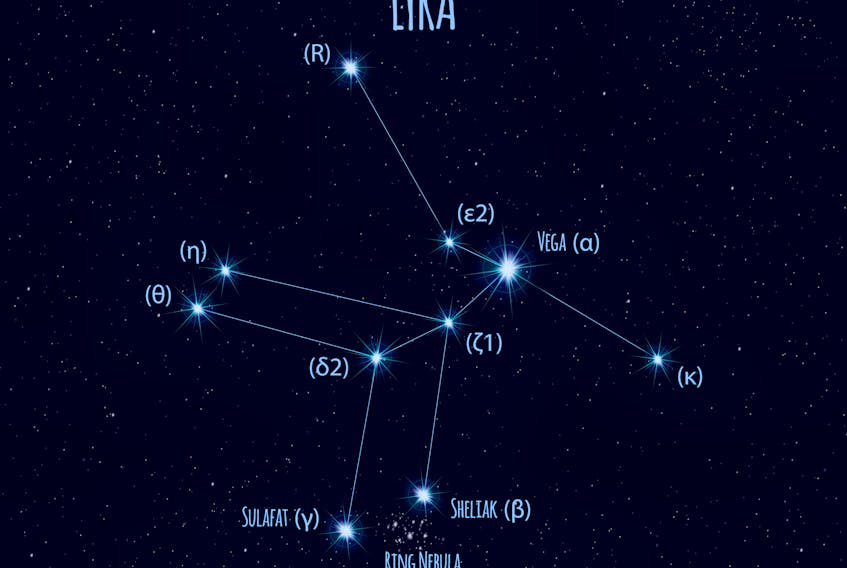While last week's column was not, in essence, about the Summer Triangle, but, rather, about the two summer constellations Cygnus - the Swan, and Aquila - the Eagle, a number of my readers wrote me, and asked why I hadn't written about Vega in Lyra (the third component star of the triangle). So, to satisfy curiosity, this week I will focus on Vega and the constellation of Lyra - the Lyre.
Lyra is most often associated with Orpheus, the mythical Greek musician/poet whose talent with the lyre (an ancient stringed instrument similar to a small harp) was said to have charmed people, animals, and inanimate objects alike, and to have even pleased the gods. Orpheus accompanied Jason and the Argonauts on their quest for the "Golden Fleece", where, it is said, his music saved the crew from the man-eating Sirens they encountered on the voyage.
Perhaps the most famous tale about Orpheus concerns his trip into Hades, the underworld, to rescue his wife, Eurydice, who had died from a snake bite. Orpheus played his lyre for Hades, god of the underworld, who was so charmed by the music that he relented and allowed Eurydice to return to the world of the living, provided that Orpheus not look back at her before she stepped clear of the entrance to Hades. Unfortunately, Eurydice tripped just before the entrance edge and cried out, causing Orpheus to look back at her, thereby breaking the sole condition of her release and losing her back into Hades, this time for eternity.
Upon his untimely and rather messy death (he was torn apart by a group of angry female followers of the god Dionysus), the gods, in honour of his great musical talent, placed the lyre of Orpheus in the heavens.
Interestingly, in ancient Egypt and India, the constellation of Lyra was depicted as a falling eagle or vulture carrying a lyre. At that time, the primary star (which we now call Vega) was known as "Wega" (from the Arabic for "swooping" or "falling").
In Wales, Lyra was known both as "King Arthur's Harp" and "King David's Harp". To the ancient aborigines of Australia, it was "Malleefowl" (after a chicken-sized, ground-dwelling bird).
The make-up of Lyra
The constellation's main star, Vega, is a variable star (magnitude -0.02 to +0.07) at 25 light years distance, is the second brightest star in the northern hemisphere and fifth brightest in the night sky overall. It was the first star (other than our sun) to be photographed (1850) and to have its light spectrum recorded (1872). Vega was the pole star (i.e., the North Star) in 12,000 BCE (before common era; i.e., before Year 1), and will, again, be the pole star around 14,000 CE (common era). The Lyrid meteor shower occurs in April of each year.
No need to drive all the way to Tim's for a double-double; you can just look up in the night sky. Epsilon Lyrae, located to the upper left of Vega (both stars are visible in a single binocular field), is a double star (seen in binos), with each component star itself a double (seen in small scopes), making Epsilon a double-double. Do you want a doughnut to go with your order?
This week's sky
Having passed inferior solar conjunction on June 30, Mercury is still too close to the sun to be visible. Jupiter is the first planet visible in the eastern sky around 10:50 p.m. (closer to 10 p.m. by July 12).
Heading for opposition on July 14, Jupiter (magnitude -2.7) reaches its highest point in the southern sky shortly after 2 a.m., before being lost to the dawn twilight around 5 a.m.
Saturn (magnitude +0.2) rises in the east around 11 p.m. (about 20 minutes earlier by July 12), reaching 23 degrees above the southern horizon shortly after 2 a.m., then fading from view shortly after 4:30 a.m.
Mars (magnitude -0.5) rises around 12:30 a.m., achieving a height of 38 degrees above the southeast horizon before being lost to the dawn twilight around 5 a.m.
Venus (magnitude -4.5) rises in the east about 3:20 a.m. (3 a.m. by July 12), reaching 16 degrees above the eastern horizon before disappearing shortly after 5 a.m. Venus reaches its greatest brightness (magnitude -4.7 )for the year on July 8.
Until next week, clear skies.
Events
July 8 - Venus at greatest brightness for 2020
July 12 - Last quarter moon at apogee (farthest from Earth)









